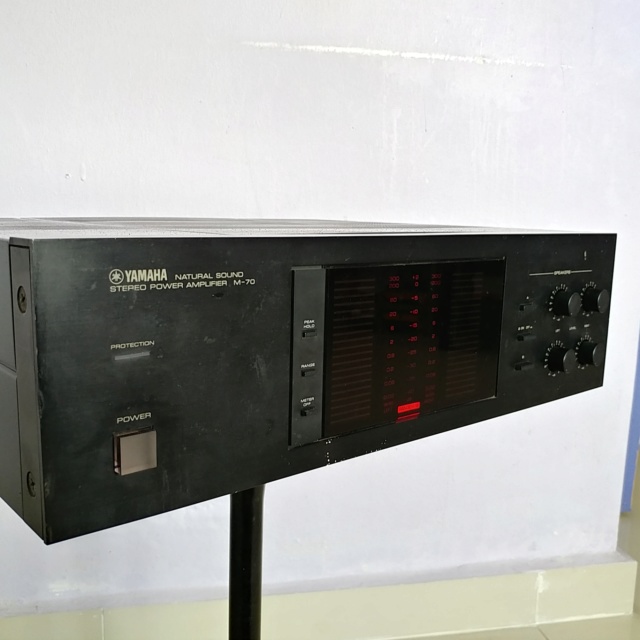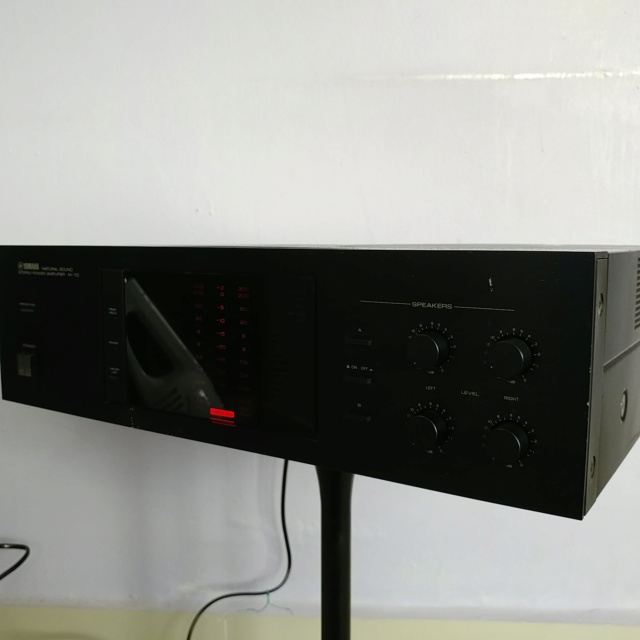Yamaha M-70 Stereo 200 Watts Per Channel Power Amplifier
Hi-Fi 4 Sale - Malaysia / Singapore Audio Forum & Marketplace | www.hifi4sale.net :: Audio & Video Equipment Marketplace :: Audio & Video Equipment: FOR SALE (Pre-owned & Used)
Page 1 of 1
 Yamaha M-70 Stereo 200 Watts Per Channel Power Amplifier
Yamaha M-70 Stereo 200 Watts Per Channel Power Amplifier





Made In Japan
Price : RM 2550
Contact Simon Ting 012-3612507
Yamaha top-line separate amplifiers are ranked among the most prestigious components produced throughout the world.
Our separate components offer performance, control versatility and reliability that equals, and usually exceeds, that of the most advanced competitive units available.
Yamaha's care and attention to detail, coupled with our awesome technological capabilities produce audio components that are unmatched by any other manufacturer.
One of the primary reasons behind our remarkable success in the audio field is Yamaha's vast musical experience and human sensitivity gained through almost a century of crafting many of the world's finest music instruments - from grand pianos to piccolos.
Much of the sophisticated analogue and digital electronic technology developed for Yamaha's highly respected contemporary music instruments and professional sound reinforcement equipment further contributes to the advancement and improvement of
our home audio components.
In addition, since all the necessary research, technical and production facilities are maintained internally, Yamaha can thoroughly guarantee the overall quality of every audio product.
And there is much more to the Yamaha audio success story.
Every new product must face a formidable challenge in proving its music reproduction accuracy: the critical ears of our music instrument designers and renowned acoustic specialists.
Part of the myriad of huge amplifiers Yamaha produced during the 1980s : well-built, powerful enough to almost drive a pair of Magnepans, looking in sync with the times (flashing red and black) and nearly indestructible.
Auto-Class A was for the later M-80 revision but the ZDR system was applied here as well as a fully DC circuit. ZDR (aka Zero Distortion Rule) is a way to re-inject the detected distortion signal but in phase-inverted mode.
The M-70 was a B-70 in Japan and a Stereo Sound "Best Product" there, alongwith the C-70.
The smaller M-50 was introduced alongside ; later replaced by the M-80 / M-60 / M-40 in 1984, all three with the added "Auto Class A" feature, somewhat bigger looks plus even more available power.
Yamaha M-70
The Pure Zero Distortion Rule Sound
Here, at last is a power amplifier output stage that actually adds no distortion to the music signal. Although the actual techno;ogy involved in the ZDR (Zero Distortion Rule) amplifier is quite sophisticated, the basic principle of this incredibile high-accuracy amplifier is quite simple. Essentially the Zero Distortion Rule system consists of a distortion detector derives a signal corresponding to any distortion products originating in the amplifier itself, and the summer adds this signal back into the original audio / distortion signal - out of phase with the original signal. This effectively cancels the distortion signal, leaving the audio signal intact and virtually distortion-free. Of course, this system has no effect on distortion originating in the source signal, only on distortion generated within the power amplifier itself. From the above description we can see that if the derived out-of-phase distortion signal were somehow made larger than the original distortion signal, summing these signals would actually result in a negative distortion product. With this ingenious system, it has become possible to produce a power output stage that actually exhibits no inherent distortion.
Zero Distortion Rule vs. Negative Feedback
Negative feedback (NFB) is the most commonly used means for reducing distortion in audio amplifiers. The amount of distortion reduction, however, is directly controlled by the amount of feedback applied. This means that in order to reduce distortion to zero, infinite feedback must be applied. Obviously, it is physically impossible to create infinite negative feedback, and therefore also impossible to achieve zero distortion by this method. Increasing application of negative feedback can only approach the zero distortion ideal, while ZDR actually permits crossing the zero distortion line and creating negative distortion, making it theoretically possible to completely eliminate distortion.
Zero Distortion Rule vs. Feed Forward
The feed forward system of distortion reduction attemps to cancel distortion by adding an inverted distortion signal to the audio signal at the amplifier's output where signal power levels are high. This means that expensive, hig-power feed forward circuitry is required, and overall power efficiency is extremely low. Also, the high-power feed forward amplifier required can actually add unwanted distortion. Zero Distortion Rule performs its distortion cancellation at the amplifier's inputs, thereby eliminating the power problem. And since the ZDR circuit is essentially concerned only with low-lwvel signals, it cannot add any distortion of its own.
Linear Transfer Bias and the "X" Amplifer
In addition to the ZDR system, the M-70 feature Linear Transfer Bias circuitry and Yamaha's remarkable "X" Power Amplifier system. The Linear Transfer Bias circuit minimizes the problem of crossover distortion due to non-uniform linearity between the power transistors in a push-pull power stage. By applying precisely calibrated bias to each transistor in the M-70's cascoded push-pull power circuit and thereby staggering the operating point of each a perfectly linear composite transfer characteristic is achieved, ensuring negligible crossover distortion levels.
The "X" Power Amplifier achieves extremely high amplification efficiency by switching the power supply voltage between two voltage levels - low and high - according to the size of the signal being processed. For average signal levels, for example, the lower supply voltage is used, while the high supply voltage is instantaneously switched in whenever a high-level music peak is detected. This system eliminates the power wasted in the form of heat that conventional systems must dissipate with large, finned "heat skins". The fact that the "X" Power Amplifier permits true high-power music amplification with maximum efficiency and minimum heat generation means that the entire amplifier circuit operates under optimum conditions at all times, ensuring the cleanest most accurate music reproduction. The unbeatable combination of the Linear Transfer Bias circuit, "X" Power Amplification, and Zero Distortion Rule amplifier design results in outstanding low-distortion power performance and incredible power efficiency for unmatched reproduction precision and exceptionally natural sound quality.
X" Power Purity
The concept of "pure power" is extremely important in achieving the highhest power amplifier performance. That is, the power source that supplies power to the actual power amplification circuitry must be capable of providing extremely stable power and at the same time supply as much power as the amplifier circuitry demends without "running out". The Yamaha "X" power supply easily meets the above requirements, with greater efficiency and power capacity than any other power system of its size or weight. In principle, the "X" power supply controls the amount of power fed from the AC line to the power supply to precisely match the amount of power supply to precisely match the amount of power consumed by the amplifier requires only a small amount of power for average music levels, or a large amount for high-level music peaks, the "X" power supply feeds precisely the required amount of power to the amplifier circuitry. Naturally, this means that all the supplied power is consumed, achieving remarkable power efficiency. In terms of stability, the "X" power supply affords exceptionally high regulation capabilities. Line supply voltage variations of as much as ±10% have no effect on the "X" power supply's output voltage, and resistance to influence by load variations is similarly high. The "X" power supply system permits the amplifier circuitry to operate at optimum efficiency under optimum conditions at all times, ensuring that the music source is reproduced with maximum accuracy.
Speaker Level Controls
In addition to speaker A/B selectors that permit one-touch selection of two sets of stereo speakers, the M-70 features independent level controls for the left and right speakers in two stereo pairs. That is, you have independent left and right speaker level controls for speaker pair "A", and left and right level controls for speaker pair "B". These controls let you independently set the maximum power level that will be sent to the respective pair of speakers, protecting low-power-capacity speakers from excessive power levels, or matching the output level of two sets of speakers of different efficiency. Independent control over left and right speaker level lets you preset the balance of your system for optimum stereo imaging depending on the positioning of your speakers and the acoustics of your listening room.
20-LED Peak Power Output Meters
These bright, attractive power meters let you see at a glance just how much power is acctually being fed to your speakers. This makes it easier to determine the proper setting of the speaker level controls to prevent speaker breakup distortion or burnout due to power levels exceeding the speaker's capacity. zFor easier reading, these advanced meters feature dual switchable ranges and s peak hold function that displays the highset encountered power levels for considerably longer than the overall meter fall time
HiFiLab- Dealer\Reseller\Trader\Service Provider

- Number of posts : 2971
Age : 45
Location : klang
Registration date : 2011-03-12
Character sheet
Source(s):
Amplification:
Speakers:
 BUMP
BUMP
Up
HiFiLab- Dealer\Reseller\Trader\Service Provider

- Number of posts : 2971
Age : 45
Location : klang
Registration date : 2011-03-12
Character sheet
Source(s):
Amplification:
Speakers:
 Bump
Bump
Up
HiFiLab- Dealer\Reseller\Trader\Service Provider

- Number of posts : 2971
Age : 45
Location : klang
Registration date : 2011-03-12
Character sheet
Source(s):
Amplification:
Speakers:
 Bump
Bump
Up
HiFiLab- Dealer\Reseller\Trader\Service Provider

- Number of posts : 2971
Age : 45
Location : klang
Registration date : 2011-03-12
Character sheet
Source(s):
Amplification:
Speakers:
 BUMP
BUMP
UP
HiFiLab- Dealer\Reseller\Trader\Service Provider

- Number of posts : 2971
Age : 45
Location : klang
Registration date : 2011-03-12
Character sheet
Source(s):
Amplification:
Speakers:
 Bump
Bump
Up
HiFiLab- Dealer\Reseller\Trader\Service Provider

- Number of posts : 2971
Age : 45
Location : klang
Registration date : 2011-03-12
Character sheet
Source(s):
Amplification:
Speakers:
 Bump
Bump
Up
HiFiLab- Dealer\Reseller\Trader\Service Provider

- Number of posts : 2971
Age : 45
Location : klang
Registration date : 2011-03-12
Character sheet
Source(s):
Amplification:
Speakers:
 Bump
Bump
Up
HiFiLab- Dealer\Reseller\Trader\Service Provider

- Number of posts : 2971
Age : 45
Location : klang
Registration date : 2011-03-12
Character sheet
Source(s):
Amplification:
Speakers:
 Similar topics
Similar topics» : Yamaha MX-A5000 11-channel Power Amplifier, 150 watts x 11
» Yamaha MX-A5000 11-channel Power Amplifier, 150 watts x 11 channels
» BGW 750G Stereo 375 watts per channel Professional Power Amplifier XLR input
» Proton AA-2120 Dual Mono High Current Stereo 120 Watts per channel Power Amplifier
» Bryston 4B ST Series 250 Watts XLR Stereo Power Amplifier
» Yamaha MX-A5000 11-channel Power Amplifier, 150 watts x 11 channels
» BGW 750G Stereo 375 watts per channel Professional Power Amplifier XLR input
» Proton AA-2120 Dual Mono High Current Stereo 120 Watts per channel Power Amplifier
» Bryston 4B ST Series 250 Watts XLR Stereo Power Amplifier
Hi-Fi 4 Sale - Malaysia / Singapore Audio Forum & Marketplace | www.hifi4sale.net :: Audio & Video Equipment Marketplace :: Audio & Video Equipment: FOR SALE (Pre-owned & Used)
Page 1 of 1
Permissions in this forum:
You cannot reply to topics in this forum








